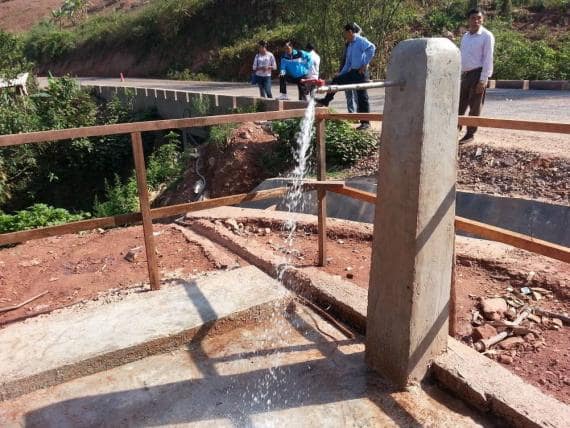Table of Contents
In this article, we will discuss public stand posts.
1. Introduction
The stand post is a central and the most frequently used component of the water supply scheme.
Public Stand Post (PSP) is a structure in the pipeline from where water is distributed to the consumers. It is generally used in the rural water supply system.
The public stand post consists of the faucet, valve, and stands post with necessary facilities of water collection, washing, and bathing.

2. Public Stand Post
Public stand post should be located at a suitable place as convenient for washing, laundering, and filling water, aesthetically pleasant, clean and inviting and also generated wastewater should be easily drained off.
Generally, the walking distance for fetching water should not be more than 50 m (80 m in exceptional cases) in vertical and 200 m (250 m in exceptional cases) in horizontal. A standing post is designed to serve 8 to 10 households. A public stand post should serve a maximum of 100 users.
The minimum discharge in a stand post should not be less than 0.1 lps and maximum discharge is limited to 0.25 lps, for adequate provision it should be 0.15 lps. When the flow in a public stand post is 0.1 lps, 2.5 minutes is required to fill a vessel of 15 liters.
A tap stand will adequately serve a population of about 100 persons at an average per capita demand of 45 liters/day with a peak factor of 3.
The minimum residual head to be maintained is 5 m. Residual head in a public stand post is desired to be of 15 m. The absolute maximum residual head is 56 m.
Construction of a tap stand includes several components: a post supporting a 15 mm mild steel riser pipe from the pipeline up to a bibcock or faucet which should discharge at least 0.1 lps, a stand on which to place a bucket; an apron to collect spillage; and a gutter and drainage to a soak way in order to prevent the breeding of flies and mosquitoes and to keep the area clean.
The height of the faucet should be 1300 mm on average above the apron. Normally faucet is not protruding more than 300 mm.
2.1. Location
The selection of place depends upon the community and drainage system available. The walking
distance to fetch the water must be less than 200m. The desirable population served by a public stand
post is 30-60 persons and the maximum population served must be limited up to 100.
2.2. Flow
The flow is adjusted by the globe valve.
Ideal flow: 0.15 lps
Minimum flow: 0.1 lps
Maximum flow: 0.25 lps
2.3. Residual Head
The residual head in the public stand post must not be too high or too low. The low residual head leads to low flow whereas the high residual head leads to high erosion. The recommended residual heads in the public stand post are as follows:
Absolute minimum: 5 meters
Most desirable: 15 meters
Absolute maximum: 56 meters
2.4. Construction
A good foundation is required for the construction of a public stand post. It may be constructed of brick, stone, or wood, using mortar or dry stone masonry.
A masonry stand post of cement mortar should have a supporting column 50 cm*50 cm around the GI pipe and should be on a footing placed 30 cm below ground level. The faucet should not protrude more than 30 cm. The adequate height of the tap is 1.2-1.5 m from the base.
| Read Also: Filter Numerical |

